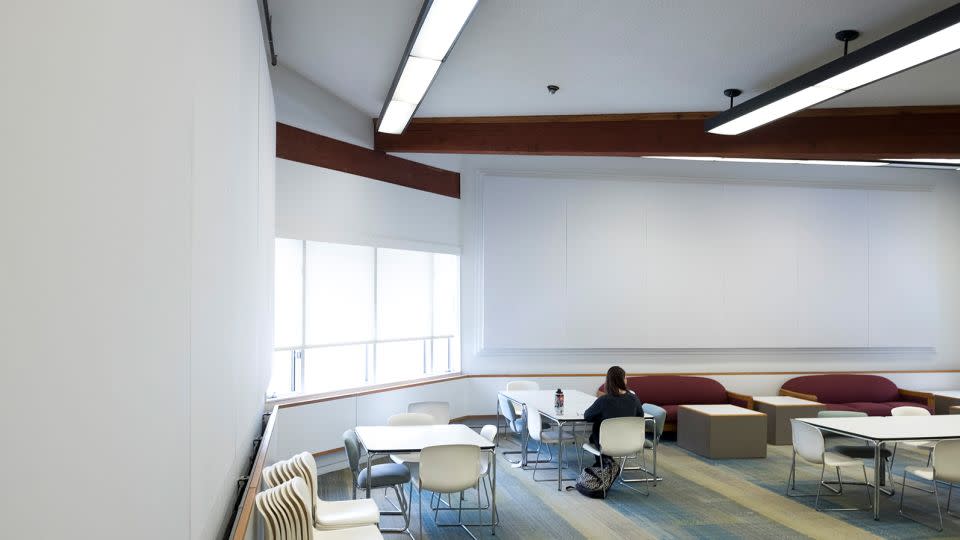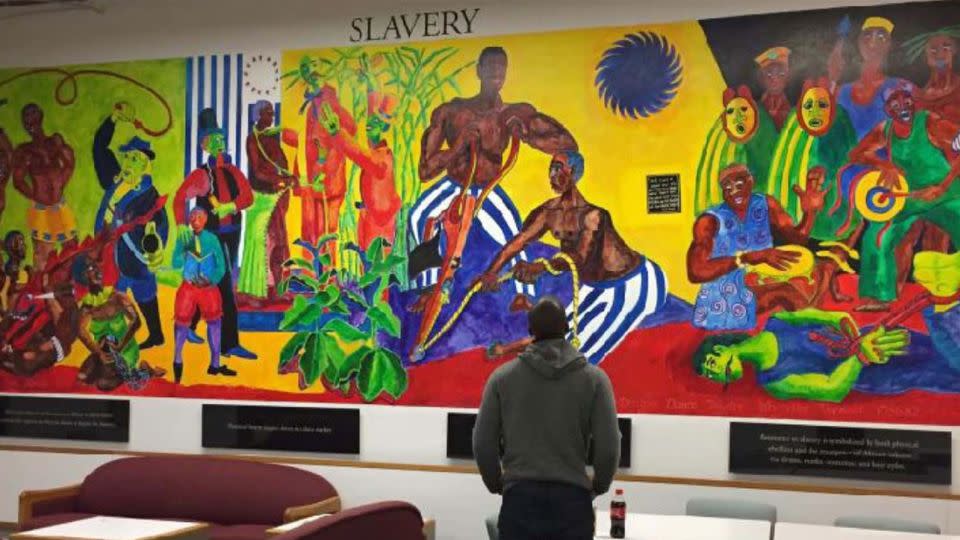Vermont law school can hide a controversial mural depicting slavery, court rules
A Vermont artist has lost his legal battle to force a law school to display a mural that portrays enslaved Black people in a style critics have called “cartoonish” and “racist.”
Sam Kerson, 76, a multi-disciplinary artist and theater director who says his work focuses on social justice, sued the Vermont Law and Graduate School in South Royalton, Vermont, in 2020, after the school’s administration erected fabric-covered panels to hide his artwork — a response to backlash over its depiction of enslaved Africans in what court documents note critics have described as an “almost animalistic style” with exaggerated facial features and physiques.
Kerson’s lawyers had argued that covering the mural violated a 1990 law that gives living artists the right to protect their work from destruction or modification. But a three-judge panel with the United States Court of Appeals for the Second Circuit sided with the school on August 18, affirming a district court decision and ruling that “mere concealment of the Murals neither ‘modifies’ nor ‘destroys’ them.”

Kerson’s attorney, Steven Hyman, called the ruling a mistake and told CNN he viewed the backlash as a “part of the cancel culture that we are experiencing.”
He said his client will be discussing whether to take his legal fight to the Supreme Court.
Eye of the beholder
“The Underground Railroad, Vermont and the Fugitive Slave” mural has long been at the center of controversy among students at the school and in the wider community.
In 1993, Kerson painted the mural’s two large panels directly onto the walls of a conference room and study center on the school’s campus. Each colorful panel is 24-feet long. The first part depicts the atrocities of slavery — among them the capture of people in Africa, the brutality of a slave market — and ends with a slave insurrection. The second panel features images of the abolitionists Harriet Beecher Stowe, John Brown and Harriet Tubman, as well as Vermonters providing help to formerly enslaved people.
“The mural is about liberation,” Kerson told CNN. “All people from Africa who are depicted in the slavery panel, they are liberating themselves … taking the great risk and the brilliant march north saying, ‘That star is north of here and by God we are going to follow it!’ That is not racist.”
Despite the artist’s intentions, however, students and community members have felt differently, and have been registering objections with the artwork with the school’s administration for more than two decades. As cited in court documents, critics have charged that the depictions of enslaved people are “Sambo”-like and portrayed Africans “in a cartoonish, almost animalistic style” with exaggerated facial features and enlarged muscles.
A steady backlash
In response to the backlash, Vermont Law and Graduate School President Rob Smolla said that a plaque was installed in 2014 to explain the mural and its message. It read, in part, that its “intent (is) to depict the shameful history of slavery as well as Vermont’s role in the Underground Railway.” But, he said, opposition to the artwork reached a fever pitch in 2020 amid a national reckoning against racist symbols like confederate statues.
The school initially offered to let Kerson remove his work — but because the mural had been painted directly onto sheet rock, that proved impossible. (To this point, the court’s ruling concludes with a note that, “nothing in our decision today precludes the parties from identifying a way to extricate (the paintings)… so as to preserve them as objects of art in a manner agreeable to all.”)

Ultimately, the school decided to erect fabric-covered panels, offset from the wall, to permanently conceal the mural’s panels without destroying them.
Kerson objected to the school’s decision, and filed his lawsuit. He has relocated to Canada in the years since the mural was painted, but has not stopped fighting for the work to be displayed. “The mural has no existence without its relationship to the viewer,” Kerson said. By being covered, he argued, “it’s made dysfunctional, it’s like painting it over.”
Justin Barnard, an attorney for the Vermont Law and Graduate School, told CNN there was “no rancor” toward the artist.
“When you are depicting someone else’s culture, and you are hearing a steady drum beat on how they are depicted… you respond and listen to the voices of those whose bodies are being depicted,” he said.
For more CNN news and newsletters create an account at CNN.com

